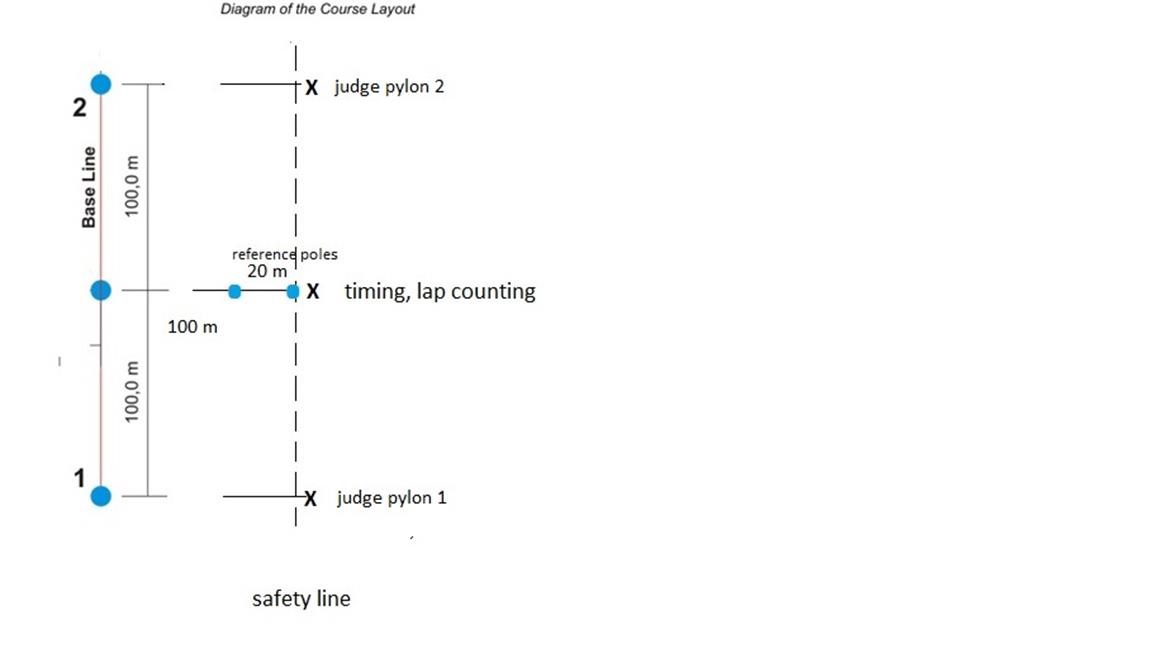FAI Extract for Speed in a closed circuit
SC4_Vol_CIAM_Records_19 Effective 1st January 2019 Page 23
5.4. Speed Records in a Closed Circuit
5.4.1. Open Records
5.4.1.1. Course
a) The course consists of two poles, defined by two prominently coloured pylons set 200 m apart situated on flat land, or land with a maximum fall not to exceed 1 metre in 200 m within 1 km of the course. Each pylon shall be numbered.
b) A line midway between Pylon One and Pylon Two (i.e. 100 m from each pole), acts as the start and finish line for time measurement midway between them.
c) Time is measured over 2 laps (4 legs).
d) For airship indoor records, the base must be 25 metres, all other dimensions proportional to the diagram for course lay-out below.

Note: It is essential for accurate speed measurement that all pylons are absolutely vertical in order to prevent course length differences with altitude.
5.4.1.2. Gliders must be free of the launching cable prior to crossing the Start/Finish line.
5.4.1.3. The flight is voided if models which land prior to completion of the course, or intrude into the forbidden airspace (except after timing is completed).
5.4.1.4. There is no altitude restriction or prohibition against circling in thermals outside the course.
5.4.1.5. Timekeeping
a) The timing of speed records must be effected by timing instruments approved by the National Airsports Control. The accuracy of the timing instruments shall be 0.01 second.
b) Timing begins when the model aircraft crosses the Start/Finish line and ends when the model after 2 full laps (4 legs) again crosses the Start/Finish line.
c) Timekeeping must be effected by two timekeepers. The difference between the times registered by the two timekeepers must not exceed 12/100 of a second.
d) The pilot, his helper, timekeepers and the timing equipment must remain at their location during the record attempt.
e) The speed is calculated by dividing the measured time over the 2 laps by 800 metres.
f) The measured speed will be rounded to the lowest 0.1 km/h.
5.4.1.6. Pylon Judges
a) The two pylon judges will be situated on the positions as indicated and will raise a well visible flag when the model aircraft or airship infringes the space bounded by the poles. Infringement is not allowed, the pilot will have to return and pass the pylon again.
b) Each pylon judge will signal with a light when the nose of the model aircraft has passed the pylon.
Other types of signals may be used, as long as they give the relevant information to the pilot.
5.4.1.7. Role of Helper
Each pilot may have one (1) helper who may launch or release the model aircraft or aerostat for take-off and keep the pilot informed of the position of his model during the record attempt but give no other assistance apart from verbal information, and give verbal information, but not other.
5.4.1.8. Minimum Difference between Consecutive Records
The minimum increase of a speed record in a closed circuit is 1%.
5.4.1.9. Safety Distances
The distance of the course to the pilots and all the officials is indicated in the diagram of the course lay out
5.4.2. Competition Records
May be set in classes F3D and F5D (records nos. 83 and 90).
5.4.2.2. Accuracy of measurement is according to class rules: 0.01 seconds, as recorded in the official results.
5.4.2.3. Minimum difference between consecutive records : 0.01 seconds.